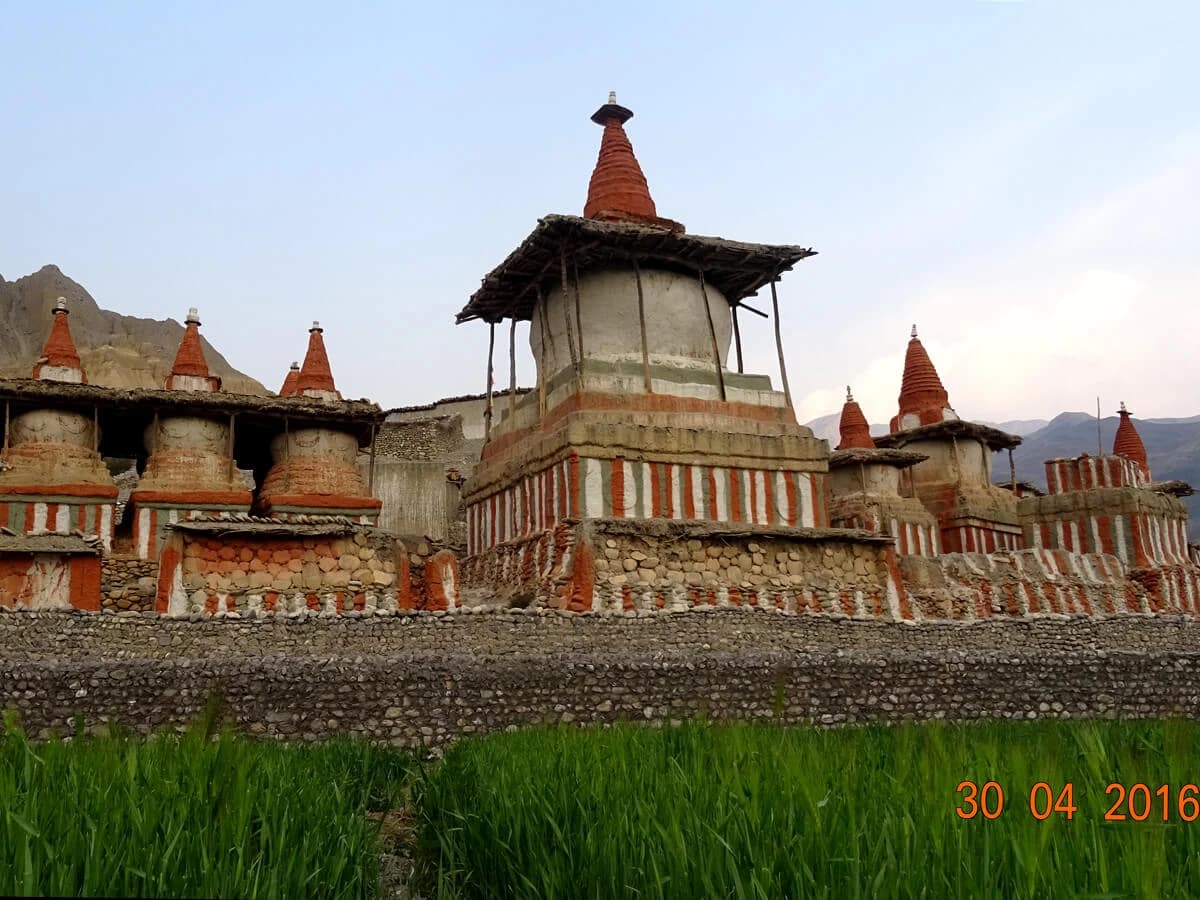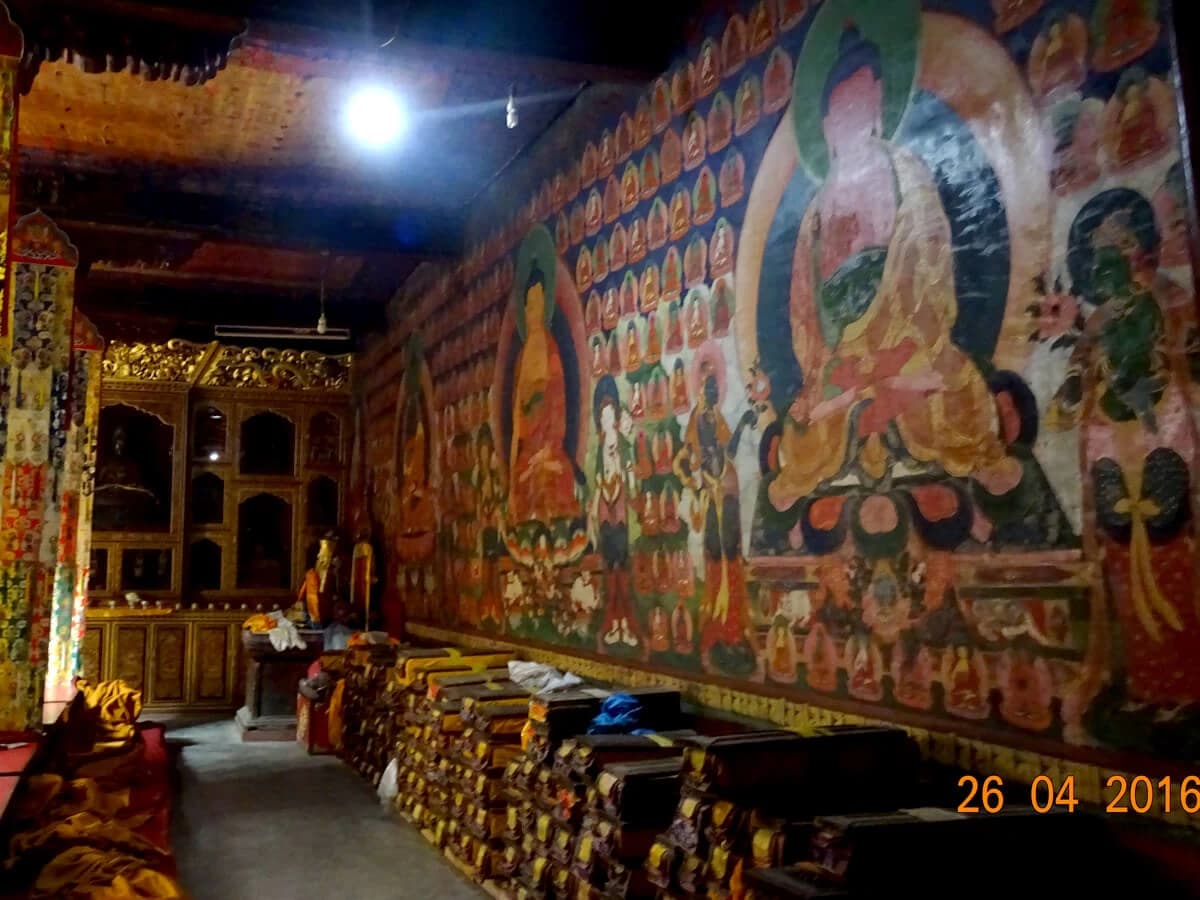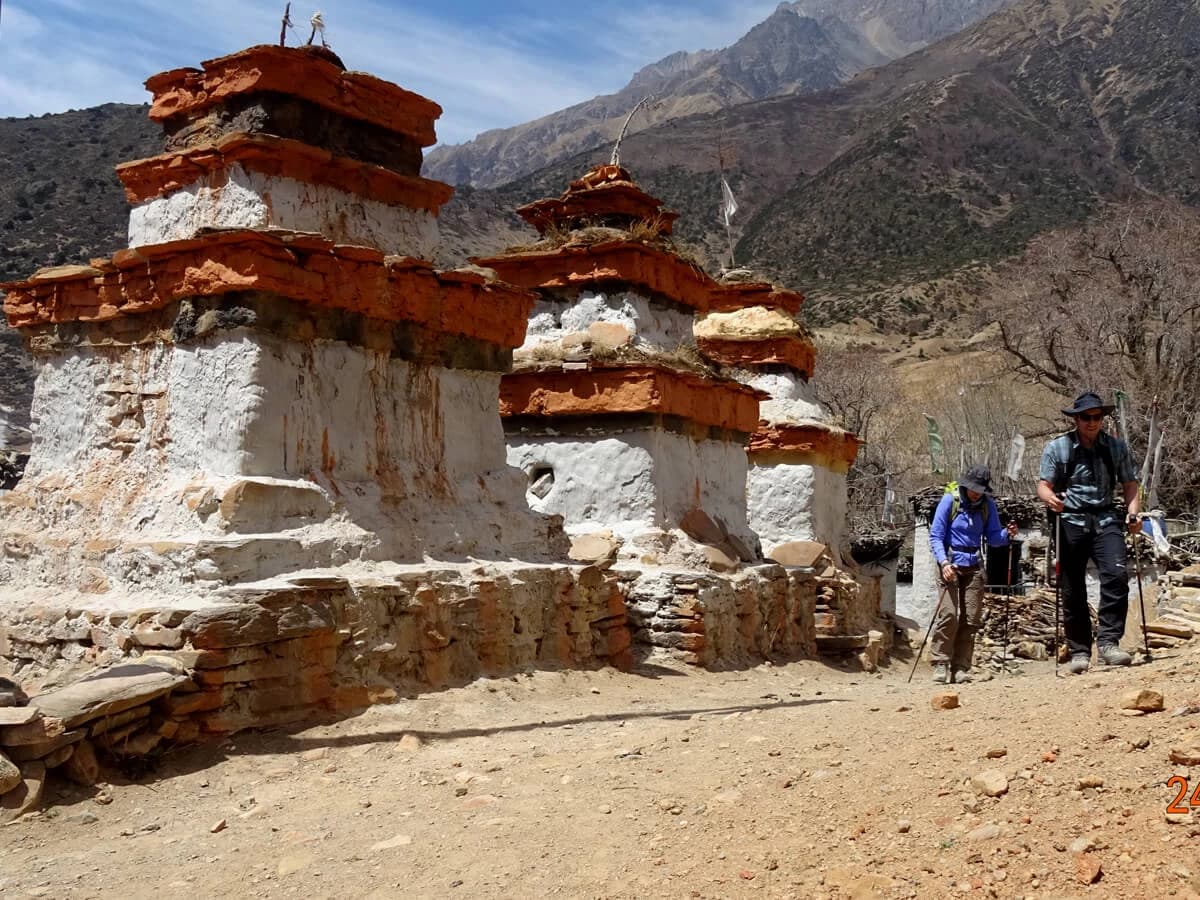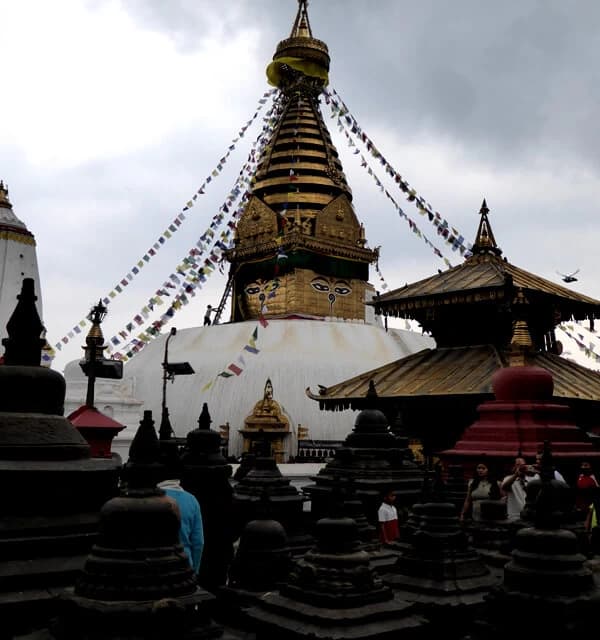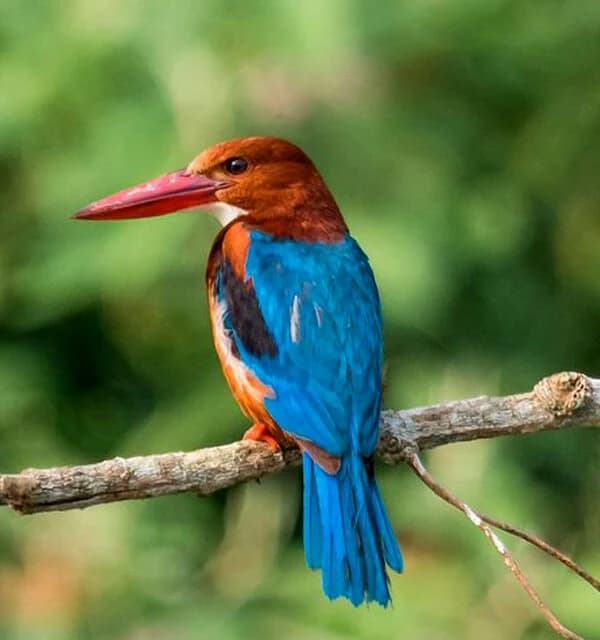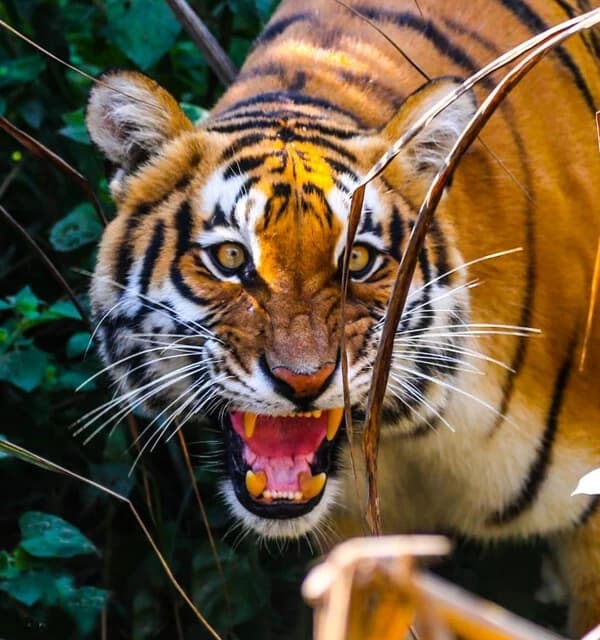Upper Mustang, a secluded Himalayan region in Nepal, is famed for its preserved Tibetan culture, ancient traditions, and stunning landscapes. Once a forbidden kingdom, it opened to tourists in 1992. The Upper Mustang Trek offers a unique adventure through timeless terrain, rich history, and vibrant culture, making it a must-visit for trekkers.
Upper Mustang Trek - 12 Days
Trip Introduction
Upper Mustang Trek: A Journey to the Last Forbidden Kingdom
Upper Mustang Trek, nestled in the rain shadow of the Himalayas, is a remote and mystical region in Nepal that offers a unique blend of natural beauty, ancient culture, and adventure. Often referred to as the "Last Forbidden Kingdom," Upper Mustang was once an independent kingdom with its own monarchy, culture, and traditions. The region was closed to foreigners until 1992, which has helped preserve its unique Tibetan culture and pristine landscapes. The Upper Mustang Trek is a journey through this hidden gem, offering trekkers an opportunity to explore a land that feels like stepping back in time.
This information will provide a comprehensive guide to the Upper Mustang Trek, covering its history, geography, culture, trekking routes, permits, best time to visit, and tips for a successful trek. Whether you are an experienced trekker or a first-time adventurer, this guide will help you plan your journey to one of the most extraordinary destinations in the world.
Upper Mustang alternative Trekking Route and Itinerary via the eastern side:
Day 01: Pokhara - Jomsom - Kagbeni (2,858m/9,375ft) 3-4 hrs.
Day 02: Kagbeni - Chele (3050m/10,004ft) 5-hour walk.
Day 03: Chele - Syanbochen (3475 m/11,398 ft): 6-7 hours walk.
Day 04: Syanbochen - Ghami (3520 m/11,546 ft) 5-hour walk.
Day 05: Ghami - Charang (3500 m/11,480 f) 4-5 hour walk.
Day 06: Charang - Lo Manthang (3700 m/12,136 ft) 5-hour walk.
Day 07: Explore Lo Manthang or visit Chhoser Valley
Day 08: Trek to Yara (3600 m), 6 hours. After the Luri Gompa excursion, if you are not exhausted,.
Day 09: Trek to Tangge (3300 m), 6-7 hours.
Day 10: Trek to Tetang (3310 m), around 9 hours. A packed lunch is required for this day.
Day 11: Trek to Muktinath (3800 m), 8-hour walk.
Day 12: Trek to Jomsom (2700 m)
Day 13: Fly to Pokhara.
Upper Mustang Trek Permit and Trip Cost
As per state law, except for Nepalese nationals, anyone entering Upper Mustang must have a restricted area trekking permit that can be attained through an authorized registered local trekking agency in Kathmandu, Nepal. The upper Mustang permit costs USD 500 per person and is valid for 10 days; each additional day costs USD 50 extra. Plus, you will need an ACAP (Annapurna Conservation Area Project) permit, which costs NPR 3000 (about USD 30 ) per person. Visitors must trek with a government-registered trekking guide. Wilderness Excursion offers our valued clients a special Upper Mustang Tour Package 2017. For further details, please kindly email us and send your requirements.
Key Highlights of the Upper Mustang Trek:
- The formerly lost kingdom of Lo Manthang is a remote and isolated region of the Himalayas
- Mustang was banned from visiting foreigners until 1992, and after that, it was opened as a restricted area.
- Experience the way of life of true mountain people, who have lived there for hundreds of years.
- Tibetan-like culture, language, and ancient Buddhist monasteries and monuments.
- The breathtaking view of barren landscapes and the stunning view of the Himalayan giants.
- All-inclusive package with internal flights and guided trek to Upper Mustang—the hidden paradise.
After breakfast take the flight to Jomsom, a scenic flight of 20 minutes over the mountains with views of 8,000ers such as Annapurna I and Dhaulagiri, brings you at Jomsom, the district headquarter of Mustang. This is a large town, headquarter of the Mustang region; it is also a major village on the Kaligandaki area linking the age old Trans-Himalayan Salt Trade route to Tibet. From Jomsom onwards it is very windy in the afternoon, Continue on the gradual path on the Kali Gandaki river bed for about 3 hours and finally reaching at Ekley-bhatti village. After good stop here an hour of easy walk takes us to Kagbeni, which is an interesting windswept villages situated on the main age old Trans-himalayan salt trade route to Tibet via Upper Mustang area. In Kagbeni a major tributary, Kak Khola, coming from Muktinath, meets Mustang Khola, and from there the river is called the Kali Gandaki.
Our journey starts with a special permit checkup and onwards to the riverbank of Kaligandaki up stream. During the walk we have scenic picturesque place to stop through the sandy and windy trails. This trails follows the up and downhill. Firstly we reach Tengbe village with narrow alleys amongst white washed houses, fields of buckwheat, barley, wheat and apple orchards. From there we trek forward to Chhusang and after crossing the river head up to the huge red chunk of conglomerate that has fallen from the cliff above, forming a tunnel through which the Kaligandaki follows. We head on to small ridges reach at Chele village.
Today, we climb to Taklam La Pass (3,624m/11,923 ft) through plateaus and narrow stretches with views of Tilicho Peak, Yakawa Kang and Damodar Danda. Further descend a little to the village of Samar. Climb the trail that goes above Samar village to the ridge then descending steeply to a stream. Another 3 hrs similar walk takes us to Syanbochen. On the way, we relax along the surrounding of cool streams and juniper trees. Locals use the dried leaves of junipers as incenses to invite deities and start any auspicious work. We also pass by a cave famously known as Ramchung Cave.
After breakfast we trek uphill to the Yamda La (3,850m /12,667ft) passing a few teahouses, chortens and local villages which is like Tibetan style of houses with open Varanda. We cross mountain passes, and an avenue of poplar trees and fields of Barley. The climb to Nyi Pass (4,010m/13,193ft) would be a little longer. Descend to our overnight stop at Ghami, the third largest village in the Lo region, Ghami is surrounded by large fields most of which are barren.
Start the trek after breakfast with a pleasant walk. After crossing Ghami Khola, the trail climbs to a plateau and passes beside a very long Mani wall, a sacred stone wall made by the followers Buddhism. From the end of the wall the trail heads east to the village of Charang with a maze of fields, willow trees and houses separated by stone walls at the top of the Tsarang Chu canyon. There is also a huge white Dzong and red Gompa to get to our teahouse for tonight's stop.
Today, we trek to Lo Manthang with a magnificent view of Nilgiri, Tilicho, Annapurna I and Bhrikuti peak. The trail first descends to Charang Chu Canyon and then climbs steeply after crossing the river. Further the trail ascends gently to the 3,850m windy pass of Lo, from where you can see the Lo Mangthang Valley. While descending to Lo Manthang, views of the walled city appear magnificent with its hills on the Tibetan Border. We stay at hotel for the overnight stop.
Visit Namgyal Gompa and Tingkhar. Namgyal Gompa situated on a hilltop serves as an important monastery of the local community and also as a local court. After visiting Namgyal Gompa continue the tour to Tingkhar, the last main village to the northwest of Lo-Mangthang and stroll back to hotel. Or you may have another option to visit the Tall Champa Lakhang "God house" the red Thugchen Gompa, Chyodi Gompa and the Entrance Hall which are the main attraction of this town. Another attraction is the four-storey building of the Raja's palace as well as the surrounding panoramic views of the Himalaya.
While returning from Lo-Mangthan, we take a different route than that we came by. Trek to Drakmar via Gyakar with more than 1200 years old Ghar Gompa with Guru Rinpoche as the primary figure. The Gompa is also famous for its rock paintings. According to the legend, anyone who makes one wish at the Ghar Gompa, their wish is fulfilled. Explore the local area. Likelihood of dusty wind, so suggested to walk in the morning.
Today, we get back to Ghiling as our journey for our overnight stay after a long walk takes 5-6 hrs. After arrival and lunch enjoy the day exploring the area, but it will be dusty wind in the afternoon, better to walk in evening time.
Ghiling to Chhuksang [3050m/10,004ft]: 5-6 hours walk. We re-track back to Chhuksang for the overnight stop after 5 housrs walk. You will have wonderful scenery during the journey with a Himalayan view. Enjoy your trip and overnight at teahouse.
Our last day of the day would be a long one. Better to walk early start as before and trek to Kagbeni. Finishing the upper Mustang trails and we join the normal Annapurna circuit trek. After lunch at Kagbeni will head on to Jomsom for the overnight stop. Or, if you can spare one more day, our guide would take you to Muktinath as well.
After morning breakfast we check in the airport to fly back to Pokhara. A 30 min dramatic flight to Pokhara between gorge of the two huge mountains Annapurna and Dhaulagiri. On arrival at Pokhara airport guide will transfer to the lakeside hotel. Rest of the time explores the lake and overnight at hotel.
We intend to keep to the day-by-day itinerary detailed as follows, even though there might be some flexibility because of local situations or other issues beyond our control. If this is the case, the trek leader will do everything possible to work out the changes to the itinerary in order to minimize your inconvenience.
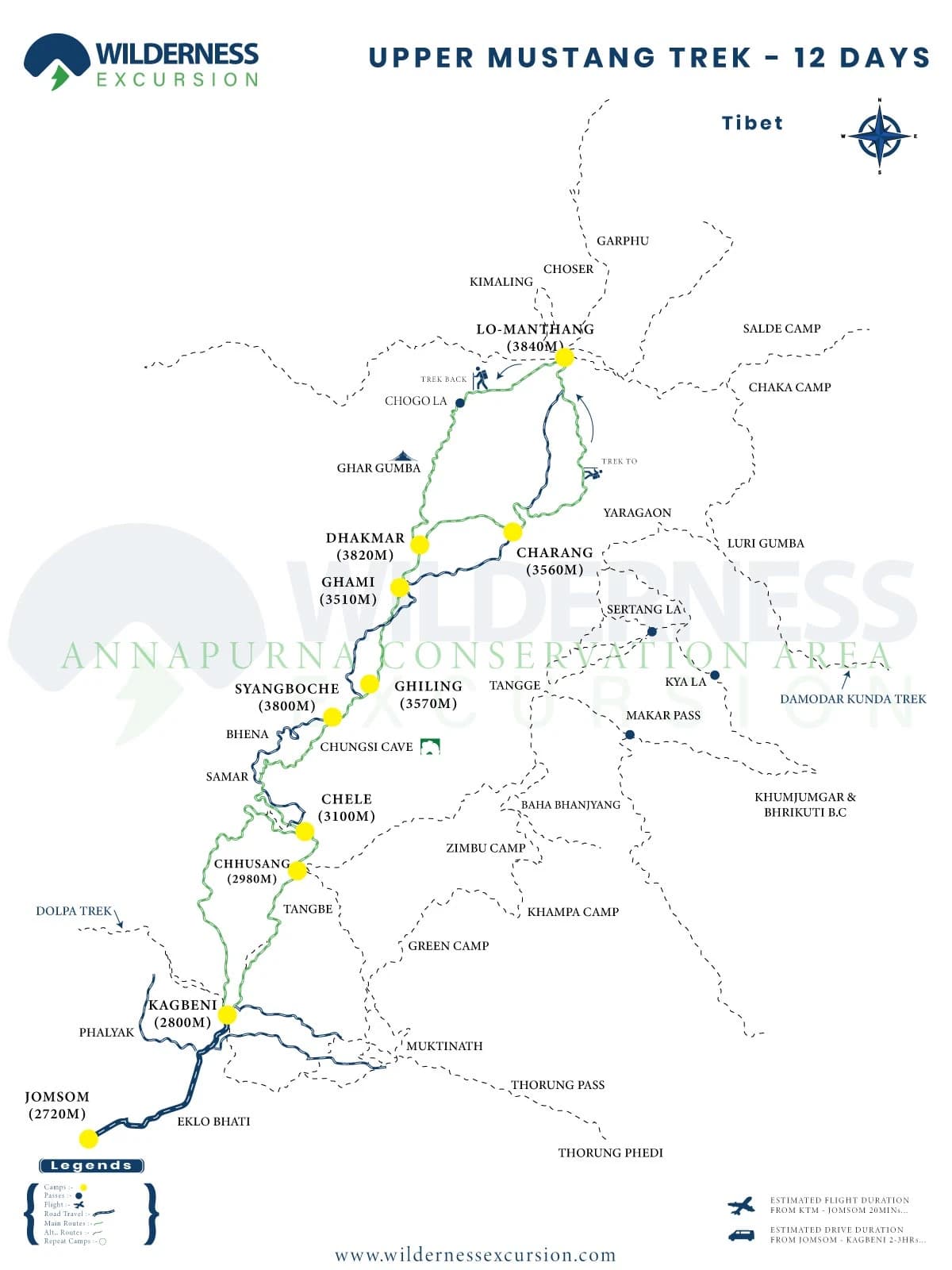
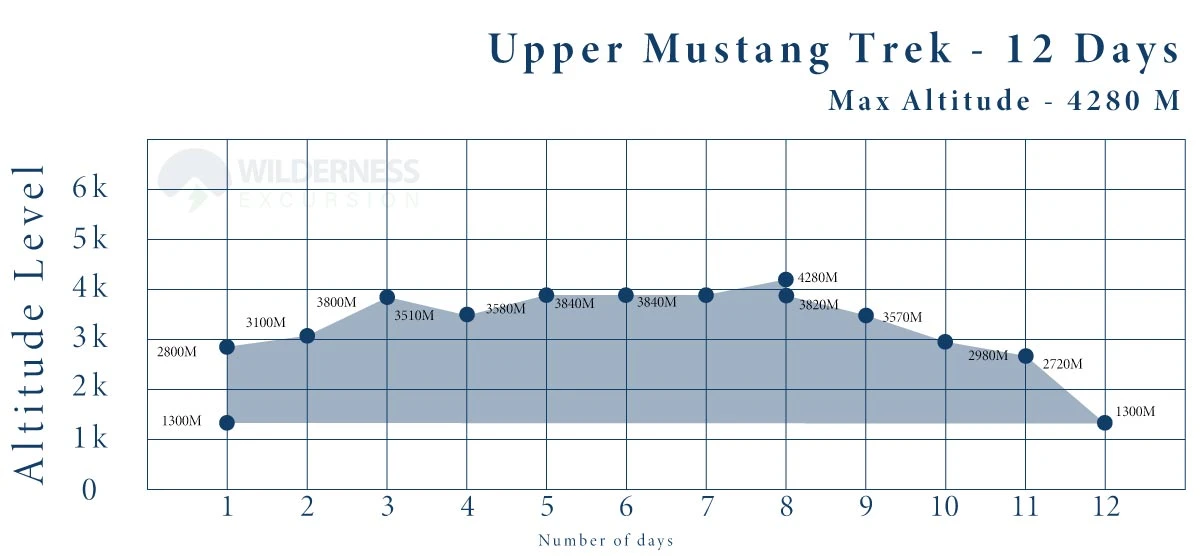
- Registered English-speaking local trekking guide.
- 1 sharing Sherpa porter between 2 travelers to carry your main pack.
- Jomsom round-trip flights with airport taxes (US$ 320 per person).
- Teahouse or trekking lodge accommodation on a twin/double sharing basis in trekking.
- Meals: 12 breakfasts, 11 Lunches and 11 dinners during the trekking.
- Upper Mustang Restricted Area Permit (USD 500.00 per person for 10 days).
- ACAP Permit and Airport taxes of domestic flights.
- Guide and porters fee with all their expenses.
- Government taxes and documentation charge.
- Transfers, accommodation & meals in Kathmandu and Pokhara
- Bar, beverage drinks and appetizers
- Personal nature expenses: toiletries, hot showers, laundry, internet and phone calls.
- Personal travel insurance and rescue operation charge in case of emergency.
- Expenses of extra adventure, extra permit fees if the trip is extended.
- Additional fees to visit monasteries in Lo Manthang and Chhoser (NPR 1000/1000 per person)
- Tipping guide and porters.
Choose a scheduled date or contact us to set up private dates or a bespoke itinerary. The minimum deposit is 15% of the total value, and the balance due is payable upon arrival.
The History and Culture of Upper Mustang
The Kingdom of Lo: Upper Mustang, also known as the Kingdom of Lo, was an independent Buddhist kingdom for centuries. The region was historically part of the Tibetan Empire and shares strong cultural and religious ties with Tibet. The Kingdom of Lo was established in the 15th century by Ame Pal, a warrior who unified the region and founded the capital city of Lo Manthang. The kingdom maintained its autonomy until the late 18th century when it was annexed by Nepal. However, the king of Lo continued to hold a ceremonial role until 2008 when Nepal abolished its monarchy.
The people of Upper Mustang are primarily of Tibetan descent and practice Tibetan Buddhism. The region is dotted with ancient monasteries, chhortens (stupas), and mani walls (stone walls inscribed with Buddhist prayers). The culture of Upper Mustang is deeply rooted in Tibetan traditions, and the people have managed to preserve their way of life despite the influence of modernization.
Religion and Festivals: Religion plays a central role in the lives of the people of Upper Mustang. Tibetan Buddhism is the predominant religion, and the region is home to several important monasteries, including the Thubchen Gompa and Jampa Gompa in Lo Manthang. These monasteries are not only places of worship but also centers of learning and cultural preservation.
One of the most important festivals in Upper Mustang is the Tiji Festival, which is celebrated in Lo Manthang. The festival is a three-day event that involves masked dances, rituals, and prayers to ward off evil spirits and bring good fortune. The Tiji Festival is a vibrant and colorful celebration that attracts both locals and tourists.
Architecture and Art: The architecture of the Upper Mustang is heavily influenced by Tibetan styles. The houses are typically made of mud bricks and have flat roofs, which are used for drying crops and storing firewood. The monasteries and chhortens are adorned with intricate carvings, paintings, and statues that reflect the rich artistic heritage of the region.
The art of Upper Mustang is deeply connected to Buddhism, and the region is known for its thangka paintings (religious scroll paintings), murals, and statues. The monasteries house some of the finest examples of Tibetan Buddhist art, and visiting these sacred sites is a highlight of the Upper Mustang Trek.
Geography and Landscape
The Trans-Himalayan Region: Upper Mustang is located in the Trans-Himalayan region of Nepal, which lies to the north of the main Himalayan range. The region is characterized by its arid and rugged landscape, with deep canyons, eroded cliffs, and barren hills. The Kali Gandaki River, one of the deepest gorges in the world, runs through the heart of Upper Mustang, creating a dramatic and otherworldly landscape.
The region is often described as a "high desert" due to its dry climate and sparse vegetation. The landscape is dominated by shades of brown, red, and gray, with occasional patches of green where crops are grown. The stark beauty of the landscape is one of the main attractions of the Upper Mustang Trek.
Flora and Fauna: Despite its arid environment, Upper Mustang is home to a variety of flora and fauna. The lower regions of Mustang are covered with juniper and pine forests, while the higher regions are characterized by alpine meadows and shrubs. The region is also home to several species of wildlife, including the elusive snow leopard, blue sheep, Himalayan griffon, and lammergeier (bearded vulture).
The Upper Mustang region is part of the Annapurna Conservation Area, which is the largest protected area in Nepal. The conservation area is managed by the National Trust for Nature Conservation (NTNC) and aims to preserve the unique biodiversity and cultural heritage of the region.
Climate and Weather: Upper Mustang has a semi-arid climate with cold winters and mild summers. The region receives very little rainfall due to its location in the rain shadow of the Himalayas. The best time to visit Upper Mustang is during the spring (March to May) and autumn (September to November) seasons when the weather is stable, and the skies are clear.
During the spring, the landscape comes alive with blooming wildflowers, and the temperatures are pleasant for trekking. In the autumn, the skies are crystal clear, offering stunning views of the surrounding mountains, including Annapurna and Dhaulagiri. The winter months (December to February) are cold, with temperatures dropping below freezing, while the summer months (June to August) can be wet and muddy due to the monsoon rains.
Trekking Routes and Itinerary
Starting Point: Jomsom
The Upper Mustang Trek typically starts from Jomsom, a small town in the Mustang district. Jomsom is accessible by a short flight from Pokhara, which offers breathtaking views of the Annapurna and Dhaulagiri ranges. Alternatively, trekkers can reach Jomsom by trekking from Pokhara via the Annapurna Circuit, which takes about 5-7 days.
Jomsom is the administrative center of the Mustang district and has basic facilities such as hotels, restaurants, and shops. From Jomsom, trekkers can either start their journey to Upper Mustang or spend a day acclimatizing and exploring the town.
Kagbeni to Lo Manthang
The trek from Jomsom to Lo Manthang, the capital of Upper Mustang, takes about 7-10 days, depending on the route and pace. The trail follows the Kali Gandaki River and passes through several traditional villages, including Kagbeni, Chele, Syangboche, Ghami, and Tsarang.
Kagbeni is the gateway to Upper Mustang and is known for its medieval architecture and ancient monastery. From Kagbeni, the trail ascends through arid landscapes, crossing high passes and offering stunning views of the surrounding mountains. The villages along the way are characterized by their whitewashed houses, chhortens, and mani walls, and provide a glimpse into the traditional way of life in Upper Mustang.
Lo Manthang is the highlight of the trek and is surrounded by a 15th-century wall that encloses the royal palace, monasteries, and residential houses. The city is a living museum of Tibetan culture and history, and trekkers can spend several days exploring its attractions, including the Thubchen Gompa, Jampa Gompa, and the royal palace.
Optional Side Trips
From Lo Manthang, trekkers can embark on several optional side trips to explore the surrounding areas. One popular side trip is to the ancient caves of Chhoser, which are believed to have been used as meditation retreats by Buddhist monks. Another option is to visit the remote village of Yara and the Luri Gompa, which is perched on a cliff and offers panoramic views of the surrounding landscape.
For those looking for a more challenging adventure, the trek can be extended to include the Damodar Kund, a sacred lake located at an altitude of 4,900 meters. The lake is considered holy by both Hindus and Buddhists and is surrounded by snow-capped peaks.
Return to Jomsom
After exploring Lo Manthang and its surroundings, trekkers retrace their steps back to Jomsom. The return journey offers a different perspective of the landscape and allows trekkers to revisit the villages and monasteries along the way. From Jomsom, trekkers can either fly back to Pokhara or continue their journey to other parts of Nepal.
Permits and Regulations:
Restricted Area Permit
Upper Mustang is a restricted area, and trekkers are required to obtain a special permit to enter the region. The Restricted Area Permit (RAP) is issued by the Nepal Tourism Board and costs 500forthefirst10daysand500forthefirst10daysand50 for each additional day. The permit must be obtained through a registered trekking agency in Nepal, and trekkers are required to travel with a licensed guide.
The RAP is designed to control the number of visitors to Upper Mustang and to protect the region's unique culture and environment. The permit also helps to support the local economy by ensuring that a portion of the fees is used for community development projects.
Annapurna Conservation Area Permit
In addition to the RAP, trekkers are also required to obtain an Annapurna Conservation Area Permit (ACAP), which costs around $20. The ACAP is issued by the National Trust for Nature Conservation and is required for all trekkers entering the Annapurna Conservation Area, which includes Upper Mustang.
The ACAP helps to fund conservation and community development projects in the region, including trail maintenance, waste management, and wildlife protection. Trekkers are encouraged to follow the principles of sustainable tourism and to minimize their impact on the environment.
Trekking with a Guide
Trekking in the Upper Mustang is only allowed with a licensed guide, and solo trekking is not permitted. The guide not only ensures the safety of trekkers but also provides valuable insights into the culture, history, and geography of the region. Most trekking agencies in Nepal offer guided tours to Upper Mustang, which include permits, transportation, accommodation, and meals.
Best Time to Visit
Spring (March to May)
Spring is one of the best times to visit Upper Mustang, as the weather is mild, and the landscape is adorned with blooming wildflowers. The temperatures during the day range from 10°C to 20°C, making it comfortable for trekking. The skies are generally clear, offering stunning views of the surrounding mountains.
Autumn (September to November)
Autumn is another ideal time to trek in Upper Mustang, as the weather is stable, and the skies are crystal clear. The temperatures during the day range from 5°C to 15°C, while the nights can be cold, especially at higher altitudes. The autumn season is also a time for festivals, including the Tiji Festival in Lo Manthang.
Winter (December to February)
Winter in Upper Mustang is cold, with temperatures dropping below freezing, especially at night. However, the days are generally sunny, and the skies are clear, offering excellent visibility. Trekking during the winter months requires proper preparation, including warm clothing and gear.
Summer (June to August)
Summer is the monsoon season in Nepal, and Upper Mustang receives some rainfall, although less than other parts of the country. The trails can be wet and muddy, and the skies are often cloudy, limiting visibility. However, the summer months are a good time to visit for those looking to avoid the crowds and experience the region's lush greenery.
Tips and information on making this trek Successful:
Physical Preparation
The Upper Mustang Trek is a moderate to challenging trek that involves walking for 5-7 hours per day over rugged terrain. Trekkers should be in good physical condition and should engage in regular exercise, including hiking, running, and strength training, in the months leading up to the trek.
Acclimatization
Altitude sickness is a potential risk when trekking in Upper Mustang, as the region reaches altitudes of over 4,000 meters. Trekkers should take their time to acclimatize and should avoid ascending too quickly. It is recommended to spend a day in Jomsom before starting the trek and to take rest days in the villages along the way.
Packing List
Packing the right gear is essential for a successful trek in the Upper Mustang. Some essential items to include in your packing list are:
- Sturdy hiking boots
- Warm clothing (layers, down jacket, thermal underwear)
- Sleeping bag (rated for cold temperatures)
- Trekking poles
- Sun protection (hat, sunglasses, sunscreen)
- Water purification tablets or filter
- First aid kit
- Camera and extra batteries
- Snacks and energy bars
A comprehensive packing list will be provided at the time of booking prior to the trek departure
Does and doesn't or trekking discipline:
Respect Local Culture
Upper Mustang is a culturally sensitive region, and trekkers should respect local customs and traditions. It is important to dress modestly, especially when visiting monasteries, and to ask for permission before taking photographs of people or religious sites. Trekkers should also avoid disturbing wildlife and should follow the principles of Leave No Trace to minimize their impact on the environment.
Stay Hydrated and Eat Well
Staying hydrated and eating well is crucial for maintaining energy levels during the trek. Trekkers should drink plenty of water and should eat a balanced diet that includes carbohydrates, proteins, and fats. Most teahouses along the trail offer a variety of meals, including traditional Nepali dishes, Tibetan bread, and pasta.
The final say
The Upper Mustang Trek is a journey to one of the most remote and culturally rich regions in the world. The trek offers a unique opportunity to explore a land that has remained largely untouched by modernity, with its ancient monasteries, traditional villages, and breathtaking landscapes. Whether you are drawn to the region's history, culture, or natural beauty, the Upper Mustang Trek is an adventure that will leave you with memories to last a lifetime.
As you plan your journey to the Last Forbidden Kingdom, remember to respect the local culture, prepare for the challenges of high-altitude trekking, and take the time to fully immerse yourself in the experience. With proper preparation and a spirit of adventure, the Upper Mustang Trek will be an unforgettable journey into the heart of the Himalayas.
Trekking to Upper Mustang Trek has difficulty level of moderate, if you follow regular classic trekking route of the Upper Mustang. This is not a comfortable and easy walk as you bear in mind that Nepal trek in the Himalaya involves ups and down however mustang trek is easy regular trekkers and mild difficult for moderate fit body trekkers. If you choose alternative route via west side to end the trek at Muktinath then it is challenging and there is road access to Upper Mustang, jeep rides are available in varies places just in case. No road access in western side and it has real hiking mountain trail.
Unfortunately the answer is “no”. Visitor travelling to Upper Mustang should buy minimum 10 days permit that cost USD 500 per head even though they are just doing one week trek. eg. It would cost just USD 350 for 7 days and USD 250 for 5 days trip if they provide per day basis permit. Trekking Agents Association of Nepal (TAAN) is trying to convince the government of Nepal to change the permit regulation so that people visiting Upper Mustang less than 10 days would be cheaper permit cost.
It is the same cost USD 500 per head for first 10 Days and after that USD 50 extra per day per person for Indian nationals as well. So it is same rate for foreigners including SAARC (South Asian Association of Regional Corporation) nationals.
The best time to trek to Upper Mustang is in July, August, and September to see the vegetation of the Himalayan arid plateau. The second-best time to trek there is March to mid-June. Mustang is under the rain shadow, so when it is monsoon (Mid June to August) in Nepal, trekking to Mustang is a good time. And it is possible to trek Mustang between all around the year except winter (Dec to February), as your trek may be affected by snowfall.
Our guide, Rahul, is incredibly knowledgeable and effortlessly brings up fascinating topics throughout the journey, sparking a deep curiosity about the surroundings. Our conversations spanned a wide range of subjects—water resources, electricity, hardwood tree species used in construction, shifting government...

We as a couple did this wonderful camping trek in April/May 2016. Everything was perfectly prepared. Pradip and his crew (guide, cook, porters) were awesome. They did everything to make it comfortable. They always had a plan b if there...
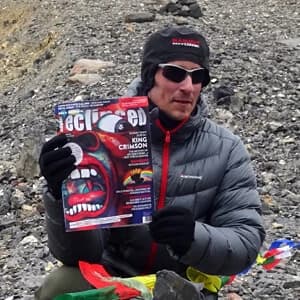
We had a great trip to Upper Mustang. Mustang is incredible, the landscapes are otherworldly. Our guide and porter were both incredibly helpful and sorted out all of our admin, meals and look after our every need - we never...
